Amazon Ec2 Instance Types
Contents
Amazon Elastic Compute Cloud (Amazon EC2) is a web service that provides secure, resizable virtual space in the cloud.
It aims to develop better web-scale cloud computing keeping the requirements of the developers in mind.
Amazon Elastic Cloud Compute EC2 is a robust web service interface. It lets you run on Amazon’s proven computing environment providing full control.
Elastic Cloud Compute (EC2) instances arrange for the resources acting as the backbone of most cloud deployments.
Amazon has created different EC2 type instances to deliver customizable and scalable server options.
Let’s understand AWS EC2 instances in details.
What are the benefits of AWS EC2?
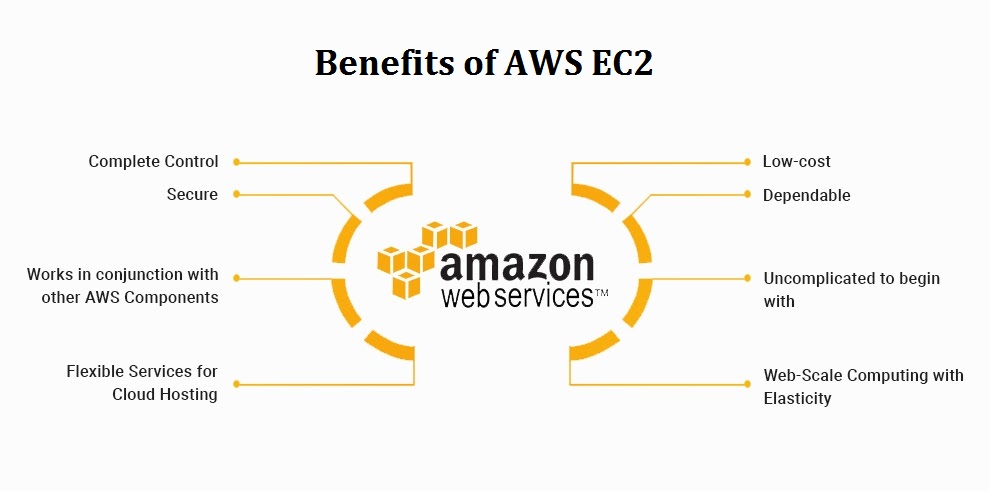
Amazon Web Services’ resources are rapidly adopting technology changes to stay at the top position and to multifold their business profits.
For cloud deployments, Elastic Cloud Compute (EC2) instances serve as the backbone of the resources provided to the clients.
In the simplest form, EC2 instances are like the server points for which we pay to web hosting companies.
Instead of web hosting companies, here we are accessing one of the EC2 instance types to run our service using Amazon’s resources.
Also Read: How To Setup EC2 Instance in AWS – Amazon EC2 Security
Building Blocks of EC2 Instances
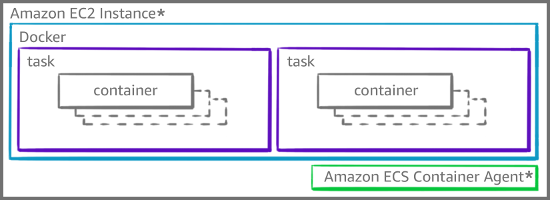
The latest cloud storage and wireless technologies have brought a revolutionized change in the way we broadcast our business reach.
Amazon EC2 instance types that provide hi-tech, improved, and secure methods.
Top Most Security with AWS Nitro System
The selection of the instance types you choose depends on the hardware of the host computer. Each instance has a different memory specification and computing type.
The instances having different capabilities are listed by the AWS. You have to select the instance types depending on your requirements of application or software that you plan to run on your instance.
Amazon allocates some resources such as CPU, memory, and instance storage when a new instance is created.
Also, Amazon EC2 shares hardware information such as the network and the disk subsystem of the host computer in the list of created instances.
The purpose of listing this information is to use shared resources. Each instance type provides higher or lower minimum performance from every shared resource.
However, EC2 instances using the nitro system is the next-generation technology that offloads the traditional virtualization functions.
There are dedicated hardware and software deployed to achieve high performance, availability, and security while reducing virtualization overhead.
The Nitro System is flexible and easy to design and rapidly deliver new EC2 instance types using shared instances.
Choice of processors
The latest generation Intel Xeon, AMD EPYC, and AWS Graviton CPUs enable you to use EC2 instances cost-effectively.
EC2 instances powered by NVIDIA GPUs and AWS Inferential are also there for workloads.
These machines help you run heavy applications such as machine learning, gaming, and graphic-intensive applications.
High-performance Storage
Amazon EC2. Instances provide better and secure storage. Amazon EBS is offered to serve the need of storage for the large volume types.
It allows you to optimize storage performance and cost for workloads. Many EC2 instance types support local NVMe SSD storage.
Enhanced Networking
AWS offers 100 Gbps enhanced Ethernet networking for compute instances which is the highest among all other services.
It helps to improve higher packet per second (PPS), lower network jitter, and lower latency.
Elastic Fabric Adapter is the preferred network interface for Amazon EC2 instances for running high-performance computing (HPC) applications.
The benefits of this are the low-latency, high-bandwidth interconnect between compute nodes.
Improved EC2 Instances with Fair Prices
If you are already using or a new user then the most important thing is to stay in touch with the changing types of EC2 instance types and the changing specifications of models and sizes.
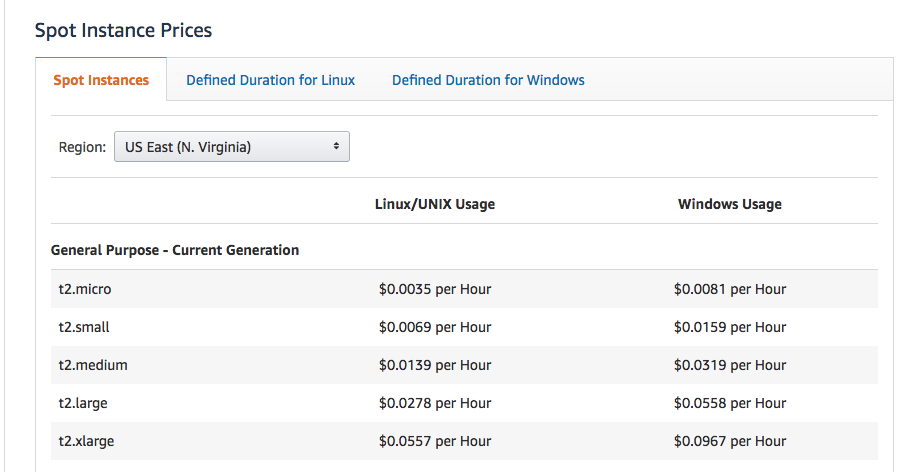
The basic instance types remain the same but due to structural changes, there is a certain change in prices and the features offered.
Depending on your budget and workload, you can choose from a Reserve Instance purchasing listing with 1-year or Flexible RI offerings.
AWS EC2 Instance Types
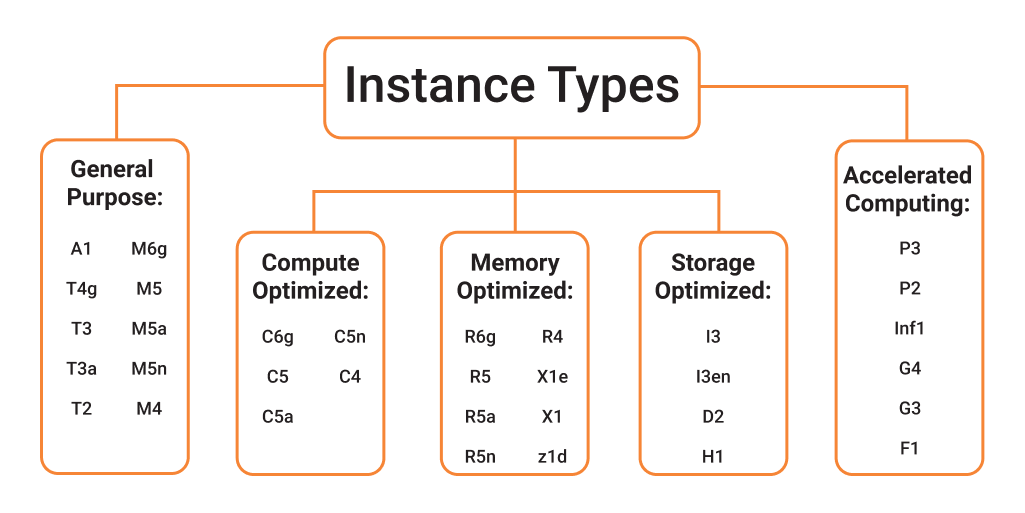
EC2 instance types can be commonly categorized as:
General Purpose:
AWS provides this environment for web servers, development, and other common applications.
Compute Optimized:
Specially designed to compute-intensive applications such as some scientific modeling or high-performance web servers.
Memory-Optimized:
Designed to handle applications that need greater memory to run. Some applications like real-time big data analytics or running Hadoop or Spark are some of them.
Accelerated Computing:
This provides the provision to access additional hardware (GPUs, FPGAs) required for parallel processing for tasks such as graphics processing.
Storage Optimized:
Designed to execute special tasks that require huge amounts of storage, specifically with sequential read-write, like log processing.
A chart of AWS EC2 types
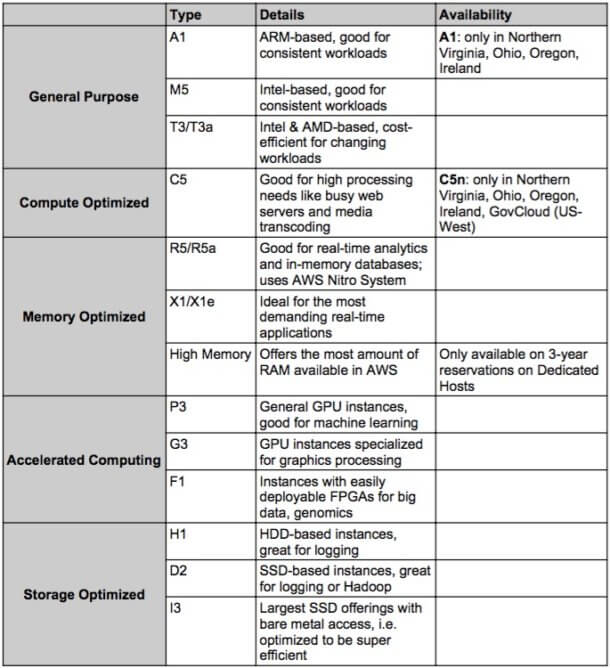
EC2 Instance Type: Detailed Study
Type: General Purpose
General-purpose instances are good to make a start using the AWS environment. With all the basic functionality, it is a cost-effective cloud environment that can effectively run mobile apps, web apps, RP and CRM apps, etc.
In this class, there are fixed and Burstable performance instances. Burstable performance EC2 instances allow you to quickly scale up your computing environment at an affordable price.
That means you can anytime upgrade your service by opting for higher range EC2 instances.
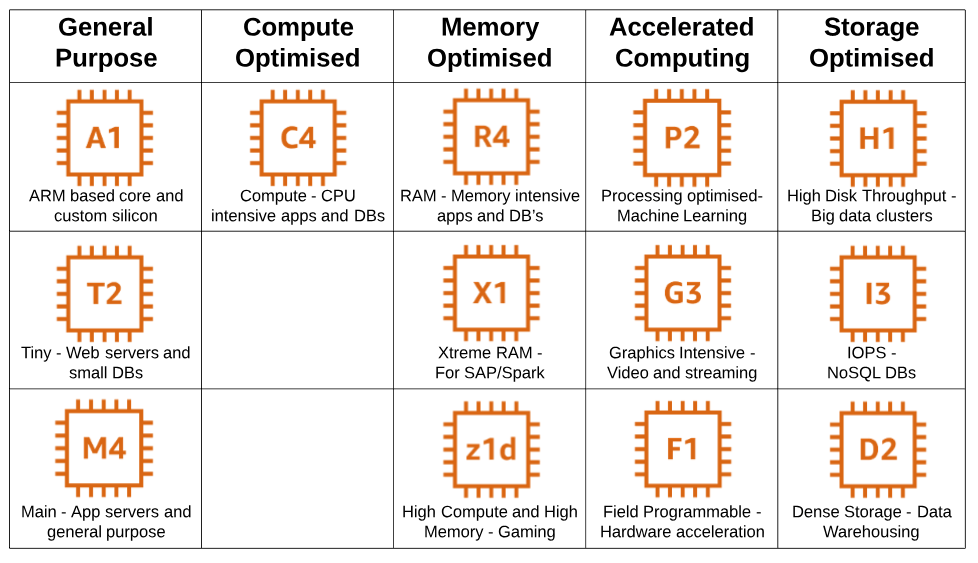
General Purpose: A1
A1 instances are general and make use of the ARM-based platform, as opposed to Intel or AMD. ARM Platform supports open-source software such as Java and Python. The multiple architectures also use the ARM platform.
General Purpose: M5
M5 instances are developed using x86 architecture and run on Intel Xeon processors. They offer higher compute memory, and network performance in comparison to A1.
M5 instances can be deployed for development and testing. They also offer support for Intel AVX-512, a set of CPU instructions supporting the encryption algorithms.
Therefore for higher security, you can opt for these instances types. Also, improved performance is ensured.
General Purpose: T3 and T3a
Another use of Burstable instances is T3 and T3a that uses Intel and AMD processors.
Burstable performance instances are slightly less powerful than the fixed performance instance (like an M5).
But to handle heavy workloads, you can opt them at a budgeted price.
These bursts are handled by CPU credits. That means you earn CPU credits when you are not running at maximum processing.
How much you can earn depends on the time at a low threshold and depending on instance type size. The credits can be used when you need to burst.
Type: Compute Optimized
Compute Optimized: C5
For applications such as gaming servers, scientific modeling, high-performance web servers, and media transcoding, compute instances are ideal to use.
They run on Intel Xeon Platinum processors at a speed of 25% faster than C4 instances. The higher speed is much useful in running bigger applications without any buffer.
Type: Memory-Optimized
Memory-Optimized: R5 & R5a
Intel and AMD have other offerings for memory-optimized instances. R5 and R5a instances are specially created for memory-based applications such as real-time big data analytics, large in-memory caches, and high-performance databases.
The R5 and R5a instances work together with the AWS Nitro System that allows them to access the compute and memory resources of a server.
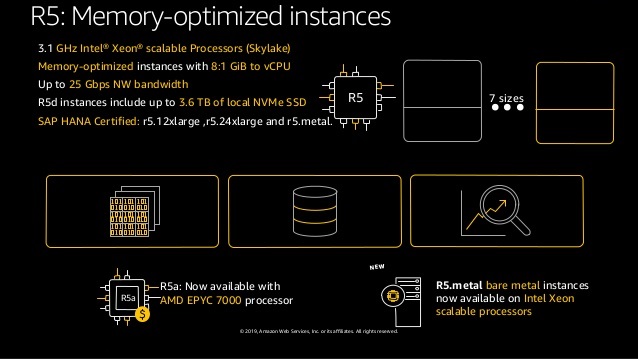
As a result, the optimization saves your money on a per/GB basis
Memory-Optimized: X1 & X1e
X1 and X1e instances are designed to provide high memory resources for computing with the X1e family.
They offer the highest memory ratio among all the EC2 instances. The intensive use of these instances is done in applications like SAP HANA, and other real-time applications.
Memory-Optimized: High Memory instances
High Memory instances provide 6 TB, 9 TB, or 12 TB of RAM which is the highest among the single instances type.
High Memory instances are designed for the use of Dedicated Hosts on a 3-year Reservation. This means that you will purchase them for at least 3-years. Instead of that, you will get the security benefit on a dedicated host.
You will have your server rather than using the AWS server on a shared basis.
Type: Accelerated Computing
Accelerated Computing: P3, G3, F1
As we have many applications that are graphics-based, especially online gaming applications.
There are special accelerated instances type that makes use of Graphical Processing Units (GPUs) or Field Programmable Gate Arrays (FPGAs).
They will optimize special tasks such as graphics processing or floating-point number calculations. The instance offerings are:
P3: It has a parallel processing ability used for general machine learning tasks.
G3: These GPU offerings are for graphics-based applications such as rendering, encoding, and streaming.
F1: These instances make use of FPGAs accelerated processing. The cab is used for advanced offerings and enhancement. With the help of FPGAs, you can get custom AMIs(called AFIs) that offer quicker deployment and development options.
Type: Storage Optimized
Storage Optimized: H1 & D2
For dense storage providing access to high sequential read-write for large data sets, like distributed Hadoop deployments, H1, and D2 instances are used.
These instances have huge storage on HDD, with H1 providing a maximum of 16 TB and D2 providing a maximum of 48 TB.
Storage Optimized: I3
I3 instances offer storage on SSD with 16 GiB. However, these instances provide lower latency than HDD-based storage.
They also make use of AWS Nitro System offerings for optimized access to memory and computer resources. This is called Bare Metal Access.
Getting Real Experience With EC2
AWS keeps introducing new EC2 instance types throughout the year. So, if you are new to AWS services or a regular user, you can keep a track of these instances types to improve your service and to use the AWS resources in a better way.
The hands-on experience gives you a more clear idea of the usage of EC2 instance types.
There is a provision that without making changes in the real-time applications, you can check the working of the new instances and upgrade the same.
Frequently Asked Question
What is AWS EC2 instance types?
There are several instance types optimized for a wide variety of use cases available in Amazon EC2. Instance types comprise varying combinations of CPU, memory, storage, and networking capacity and give you the flexibility to choose the appropriate mix of resources for your applications.
How many types of EC2 instances are there?
There are eight instance types available in the Amazon EC2 cloud that are categorized based on use cases. Instance types comprise varying combinations of CPU, memory, storage and networking capacity to give the client a flexibility to choose the appropriate mix of resources for your applications
What are the differences between the AWS instance types?
Each Amazon RDS instance is split into three classes based on the amount of processing power and it’s the amount of memory. General Purpose (db…z1d), and Burstable Performance (db. t2, db. t3), and also have multiple size options within each of the instance types
What is instance family in AWS?
There total of 8 families of instance types with different options for CPU, memory, and network resources: … M3 and M4 instances provide a balance of CPU, memory, and network resources and are ideal for running small and midsize databases, more memory-intensive data processing tasks, caching fleets, and backend servers.
How do I find my instance type?
Find an instance type using the console
- From the navigation bar, select the Region in which to launch your instances. …
- In the navigation pane, choose Instance Types.(Optional) Choose the
- preferences (gear) icon to select which instance type attributes to display,
- such as On-Demand Linux pricing, and then choose Confirm.
Which AWS instance should I choose?
For applications that benefit from a low cost per CPU, you should try compute-optimized instances (C1 or CC2) first. For applications that require the lowest cost per GiB of memory, we recommend memory-optimized instances (M2 or CR1).
Conclusion
Amazon EC2 provides a wide selection of instance types optimized to fit the different use of applications. Instance types comprise varying combinations of CPU, memory, storage, and networking capacity. They provide the flexibility to choose the appropriate mix of resources to run applications more efficiently. Each instance type includes one or more instance sizes, allowing you to scale your resources to match the needs of your target workload.
RedBlink is an AI consulting and generative AI development company, offering a range of services in the field of artificial intelligence. With their expertise in ChatGPT app development and machine learning development, they provide businesses with the ability to leverage advanced technologies for various applications. By hiring the skilled team of ChatGPT developers and machine learning engineers at RedBlink, businesses can unlock the potential of AI and enhance their operations with customized solutions tailored to their specific needs. Contact us today.

Director of Digital Marketing | NLP Entity SEO Specialist | Data Scientist | Growth Ninja
With more than 15 years of experience, Loveneet Singh is a seasoned digital marketing director, NLP entity SEO specialist, and data scientist. With a passion for all things Google, WordPress, SEO services, web development, and digital marketing, he brings a wealth of knowledge and expertise to every project. Loveneet’s commitment to creating people-first content that aligns with Google’s guidelines ensures that his articles provide a satisfying experience for readers. Stay updated with his insights and strategies to boost your online presence.
